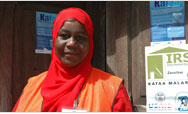USAID's Environmental Health Projects
Environmental health projects and activities supported by USAID include:
- The Hygiene Improvement Project (HIP)
HIP is designed to work at scale, focusing on behavior change to improve child health outcomes in targeted countries. The project aims to achieve sustainable improvement in three key hygiene practices — handwashing with soap, safe storage and treatment of water and safe disposal of feces — each of which can reduce the prevalence of diarrheal diseases by at least 30 percent.
- Centers for Disease Control and Prevention/Safewater
The Safe Water System (SWS) is an intervention that employs simple and inexpensive technologies to improve water quality. The purpose of SWS is to make water safe through disinfection and safe storage at the point of use, such as the household, schools, clinics, etc.
- Point-of-Use Water Disinfection and Zinc Treatment (POUZN)
The goal of the POUZN project is to expand the long-term, sustainable, commercial availability of zinc and POU to reduce mortality and morbidity from diarrhea. Project implementation will be done through social marketing projects and public-private partnerships.
Additional information on these projects can be found on the Environmental Health at USAID website.
|


